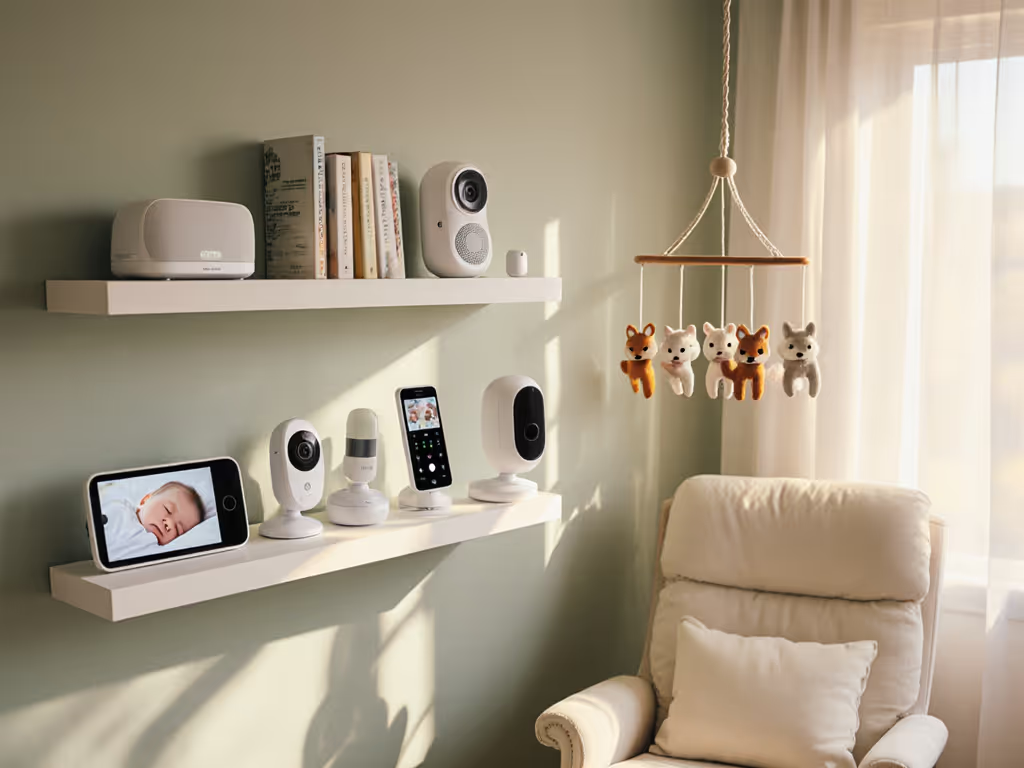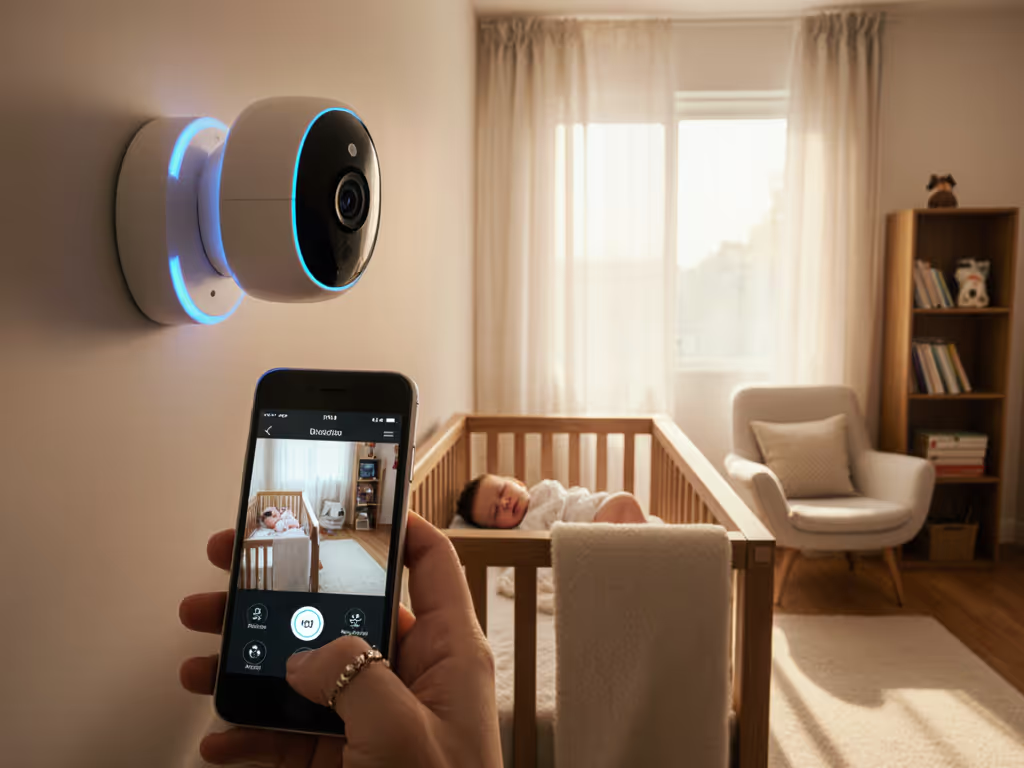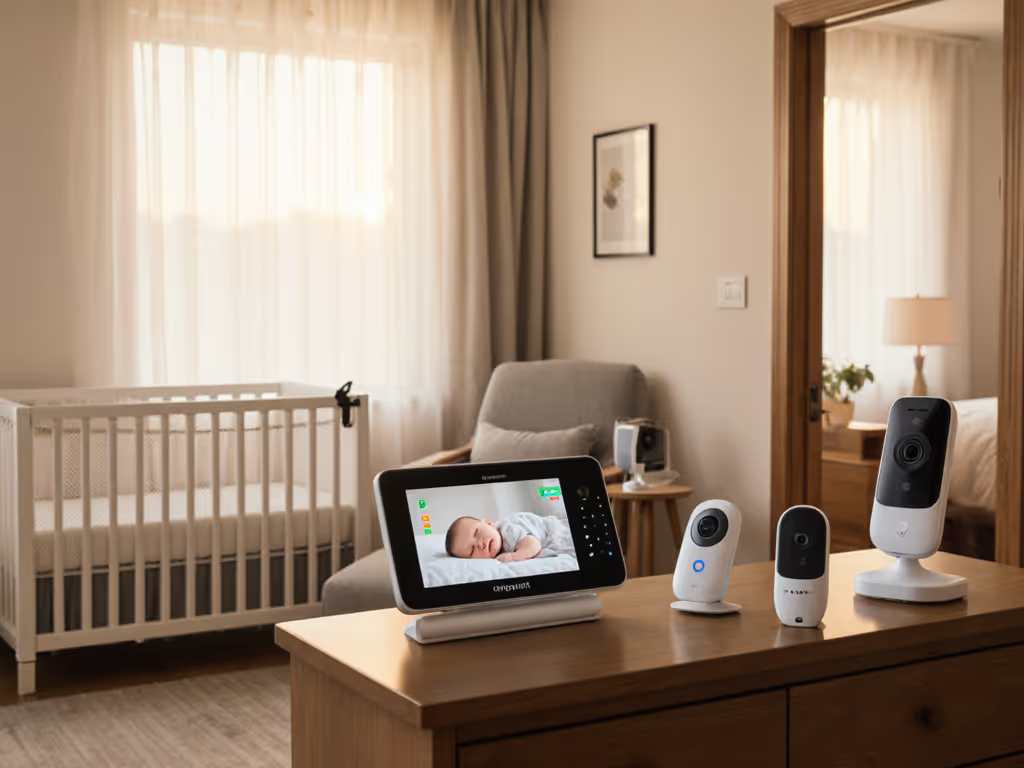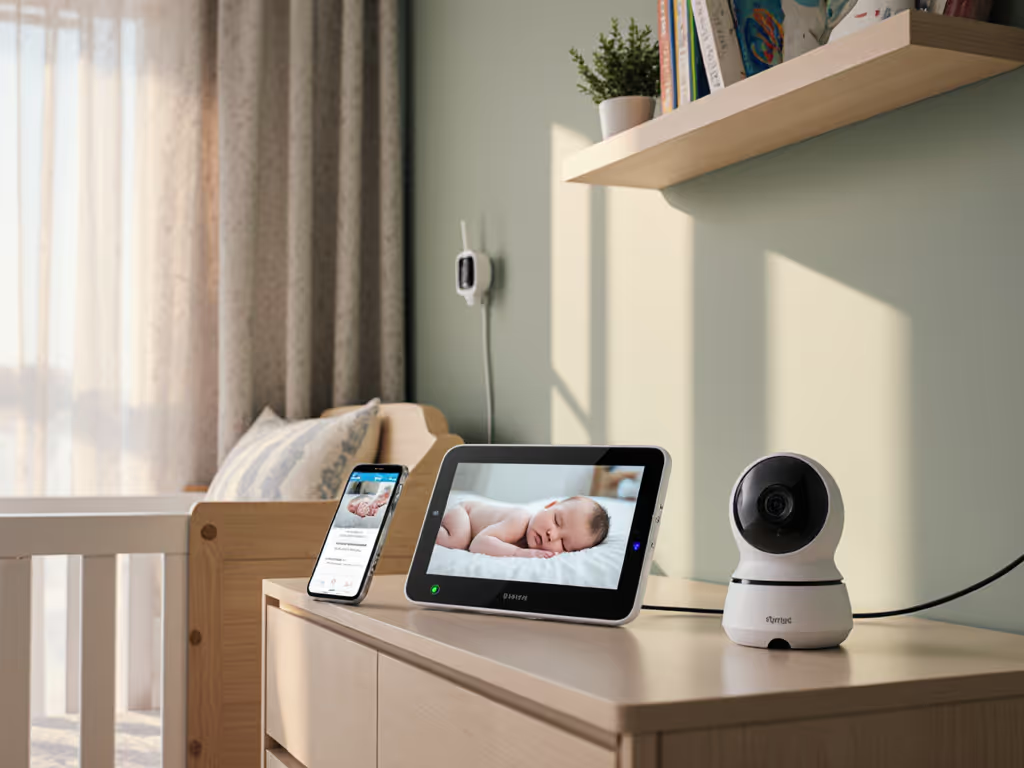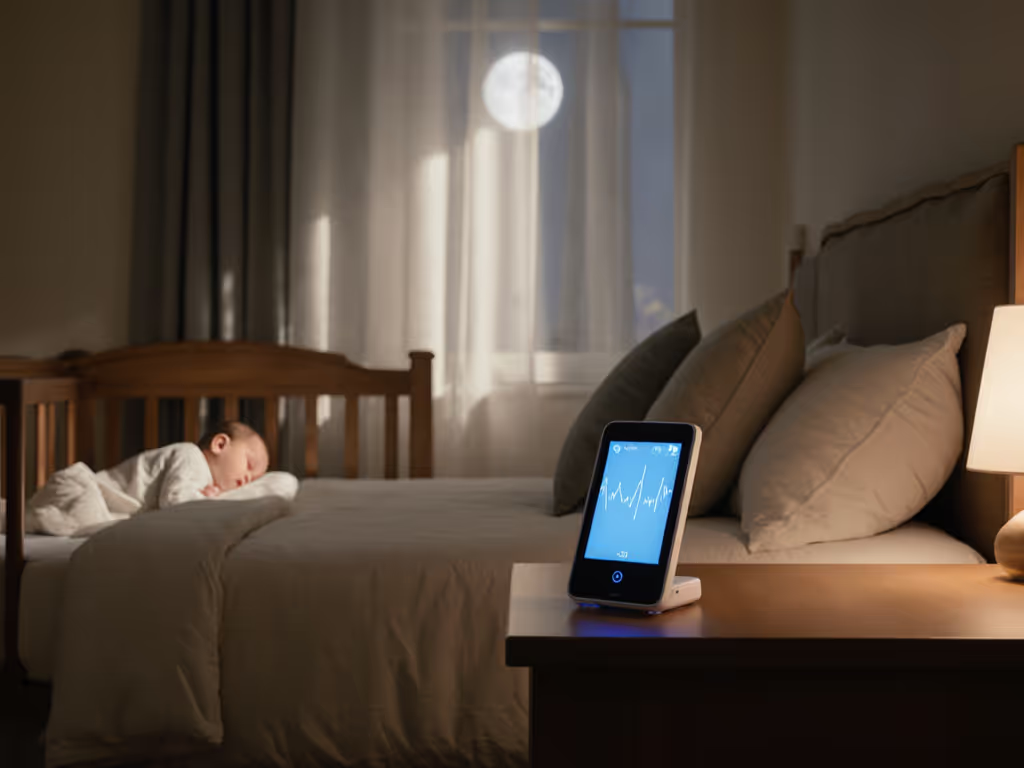
Complete Guide to the Role of Baby Monitor Placement
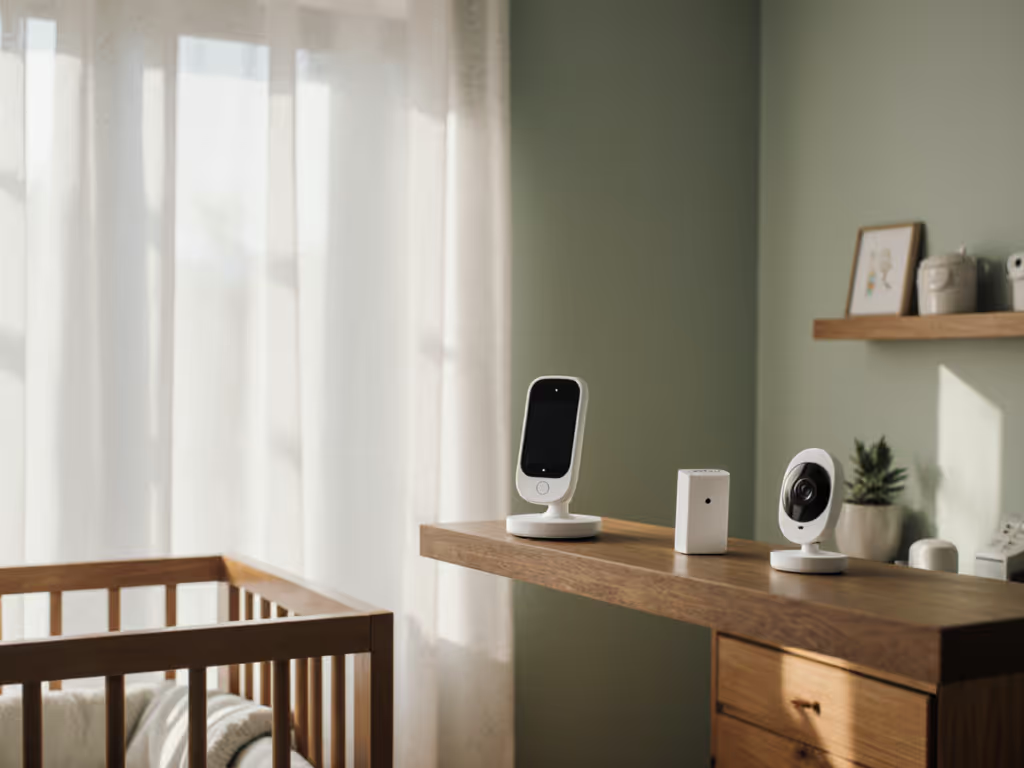
Did you know that over 2,000 infants are injured each year due to improper nursery equipment placement, including baby monitors? Where you position a monitor is more than just technical setup—it can make a real difference in your child's safety and your peace of mind. Parents often overlook the risks, yet simple changes to monitor placement can help prevent accidents and ensure you see and hear everything that matters while your baby sleeps.
Key Takeaways
| Point | Details |
|---|---|
| Monitor Placement | Maintain a minimum distance of three feet from the crib to enhance safety and ensure optimal visibility. |
| Safety Protocols | Secure all electrical cords and regularly inspect for potential hazards to prevent risks of strangulation and electrical accidents. |
| Digital Security | Choose monitors with strong encryption and regularly update firmware to protect against cybersecurity vulnerabilities. |
| Comprehensive Coverage | Position monitors near ceilings and in corners to maximize room visibility while minimizing electromagnetic exposure. |
Defining the Role of Baby Monitor Placement
Baby monitor placement might sound simple, but it's a critical aspect of infant safety that many parents overlook. Proper positioning isn't just about capturing a clear view of your little one it's about creating a secure monitoring environment that protects and informs.
The primary goal of baby monitor placement revolves around three key objectives: safety, visibility, and signal strength. Parents must strategically position monitors to prevent potential hazards while ensuring comprehensive room coverage. Safety considerations are paramount high-quality monitors should be mounted at least three feet away from the crib, with all electrical cords securely fastened and out of an infant's potential reach. This critical distance helps prevent accidental strangulation or electrocution risks that can emerge from improperly placed monitoring devices.
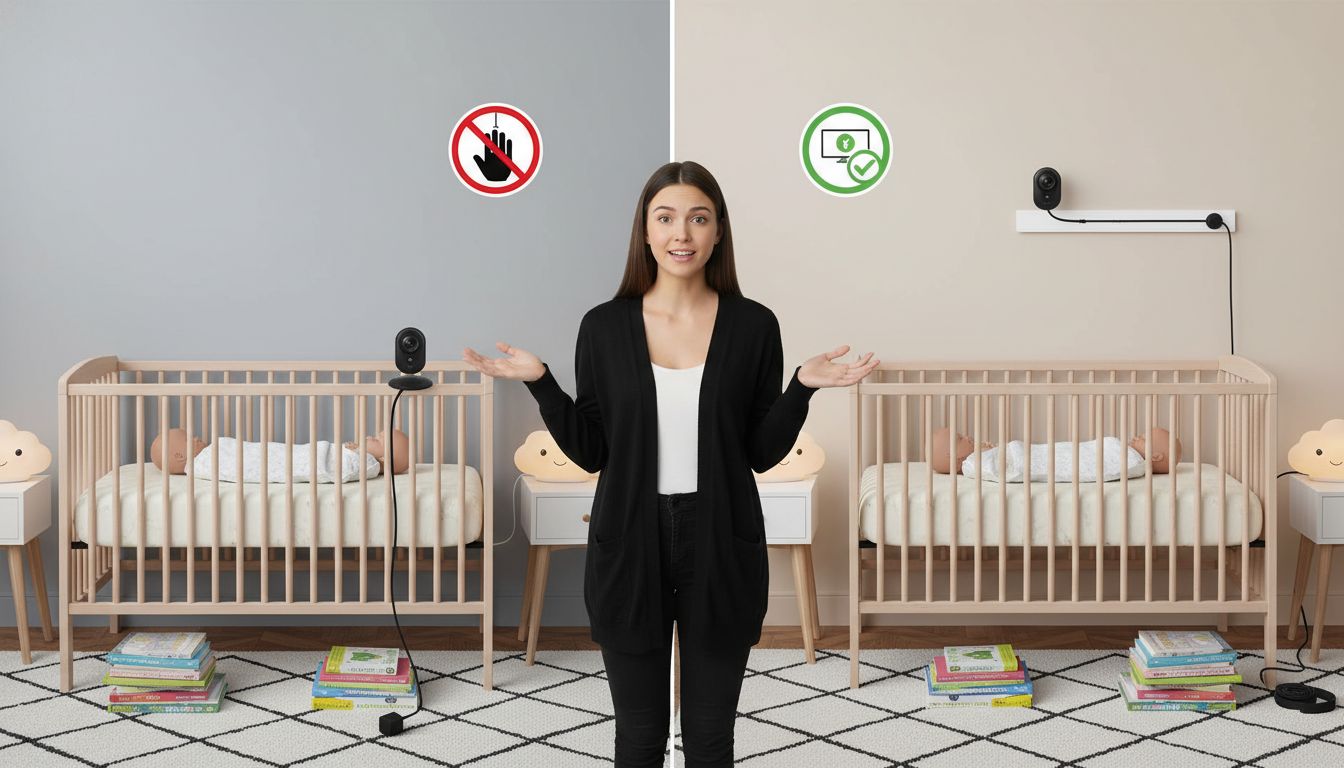
Key Placement Principles
- Maintain a minimum 3-foot distance from the crib
- Secure all electrical cords and cables
- Position camera for full room visibility
- Avoid direct line of sight above the baby's sleeping area
- Consider potential cord entanglement zones
- Test monitor signal strength in multiple room locations
Beyond physical safety, effective monitor placement supports comprehensive parental monitoring. By carefully selecting camera angles and positions, parents can observe their infant's entire sleep environment tracking movements, breathing patterns, and potential disruptions without constant physical presence. This approach transforms baby monitors from simple recording devices into intelligent safety tools that provide real-time insights and peace of mind.
Successful baby monitor placement requires thoughtful evaluation of your specific nursery layout, understanding potential risks, and making informed positioning decisions. Remember: your goal isn't just capturing an adorable sleeping baby it's creating a safe, monitored environment that keeps your little one protected while giving you the confidence to manage household tasks without constant worry.
Types of Baby Monitors and Placement Needs
Baby monitors have evolved dramatically, offering parents an incredible range of technological options for keeping their little ones safe. From basic audio devices to sophisticated smart monitors, understanding the unique placement requirements for each type is crucial for effective infant monitoring.
The landscape of baby monitors now includes several distinct categories, each with specialized monitoring capabilities. Audio monitors represent the most traditional option, transmitting sound from the baby's room to a parent unit. These simple devices require careful placement near the crib to capture clear sound while maintaining safe distances. Video monitors offer more comprehensive tracking, demanding strategic positioning to provide an unobstructed view of the entire sleeping area. Wi-Fi enabled monitors introduce additional complexity, requiring strong signal strength and secure network placement.
Monitor Types and Placement Considerations
-
Audio Monitors
- Optimal placement: 3-4 feet from crib
- Avoid electrical outlets and cord interference
- Ensure clear sound transmission
-
Video Monitors
- Mount camera at eye level for best view
- Keep at least 3 feet from crib edges
- Angle for full room visibility
-
Movement Detection Monitors
- Sensor pad placed directly under mattress
- Main unit positioned away from potential infant reach
- Check sensor alignment regularly
Specialized monitors like breathing and movement trackers require even more precise placement. These advanced devices often include sensor pads positioned directly under the mattress or wearable technology that tracks infant vital signs. Proper positioning becomes critical not just for monitoring effectiveness but for preventing potential interference with the baby's sleep environment.
Here's a comparison of baby monitor types and their optimal placement:
| Monitor Type | Placement Guidelines | Key Safety Tips |
|---|---|---|
| Audio | 3-4 feet from crib<br>Avoid cord proximity | Secure cords<br>Clear sound zone |
| Video | Mount at eye level<br>3+ feet from crib<br>Angle for full view | Keep out of reach<br>Check for blind spots |
| Movement Detection | Sensor pad under mattress<br>Main unit away from crib | Check sensor alignment<br>Regular inspections |
| Smart/Wi-Fi | Near strong Wi-Fi signal<br>6+ feet from crib | Use encryption<br>Update firmware |
Ultimately, selecting the right monitor and placing it correctly isn't about purchasing the most expensive technology.
It's about understanding your specific nursery layout, your baby's unique needs, and creating a monitoring system that provides comprehensive safety without introducing additional risks.
Safety and Privacy Considerations in Setup
When setting up a baby monitor, parents must navigate a complex landscape of physical safety and digital privacy concerns. Electronic monitoring introduces multiple potential risks that extend far beyond simple device placement, requiring a comprehensive approach to protecting both your infant's immediate physical environment and long-term digital security.
Radiation exposure represents a critical consideration in modern baby monitor setup. Wireless devices emit constant microwave radiation, making strategic positioning essential. Experts recommend maintaining at least 20 cm (8 inches) distance from the baby, with some professionals suggesting even greater separation to minimize potential health risks associated with prolonged electromagnetic exposure. The developing infant brain remains particularly sensitive to these environmental factors, underscoring the importance of thoughtful monitor placement.
Critical Safety Checkpoints
- Keep all electrical cords minimum 3 feet from crib
- Position monitors outside infant's physical reach
- Use cord management solutions to prevent entanglement
- Select monitors with encrypted digital transmission
- Regularly inspect mounting hardware and connections
- Disable unnecessary wireless features when not in use
Digital privacy vulnerabilities present another significant concern. Wi-Fi enabled monitors can potentially be hacked, allowing unauthorized access to your infant's personal space. Parents should prioritize monitors with robust security protocols, including end-to-end encryption, secure password protection, and manufacturers with strong track records of addressing cybersecurity vulnerabilities. Avoid using default passwords and regularly update device firmware to minimize potential digital intrusion risks.
Ultimately, creating a safe monitoring environment requires a holistic approach. It's not just about preventing physical hazards or digital breaches but about establishing a comprehensive system that provides peace of mind. By understanding potential risks, selecting appropriate technology, and implementing careful placement strategies, parents can transform baby monitors from potential threats into reliable guardians of infant safety.
Optimal Placement Strategies for Best Performance
Creating the perfect baby monitor setup isn't about complicated technology—it's about strategic room mapping that maximizes visibility while minimizing potential risks. Parents need a comprehensive approach that considers room layout, furniture positioning, and the specific capabilities of their monitoring device.
The golden rule of baby monitor placement revolves around achieving comprehensive room coverage without compromising safety. Experts recommend mounting monitors near the ceiling, preferably in corner locations that provide a wide-angle view of the entire sleeping area. Positioning the device approximately six feet away from the crib helps reduce electromagnetic radiation exposure while ensuring an unobstructed view of your infant's environment. This strategic placement allows for maximum visual monitoring without creating potential hazard zones near the baby's sleeping space.
Strategic Placement Techniques
- Mount monitor at ceiling level for widest coverage
- Position in room corners for optimal angle
- Maintain 6-foot distance from crib
- Ensure clear line of sight to entire sleep area
- Avoid direct overhead placement
- Check multiple viewing angles before finalizing
Not all rooms are created equal, which means placement flexibility becomes crucial. Nurseries with unique architectural features—like angled ceilings, alcoves, or irregular room shapes—require more nuanced monitoring strategies. Parents should conduct multiple test runs, adjusting the monitor's position to eliminate blind spots and ensure consistent, clear visual tracking. Some monitors offer adjustable mounting brackets, allowing fine-tuned positioning that adapts to your specific room configuration.
Ultimately, optimal baby monitor placement is a personalized science. It demands careful observation, periodic reassessment, and a willingness to adjust as your baby grows and room dynamics change. The goal isn't perfection, but creating a monitoring environment that provides peace of mind while respecting your infant's safety and comfort.
Common Mistakes and How to Avoid Them
Navigating baby monitor placement is like walking a tightrope between technological convenience and critical safety. Parental instincts often lead well-meaning caregivers into unexpected pitfalls that can compromise infant safety and monitoring effectiveness.
One of the most dangerous positioning errors involves cord placement and proximity to the crib. Many parents unknowingly create potential strangulation hazards by positioning monitors too close to their infant's sleeping area. Safety guidelines mandate maintaining a minimum three-foot distance from the crib, with all electrical cords securely fastened and completely out of an infant's potential reach. This isn't just a recommendation—it's a critical safety protocol that prevents accidental entanglement or electrical risks.
Critical Mistake Prevention Checklist
- Never place monitor inside or on crib edges
- Keep all cords at least 3 feet from sleeping area
- Avoid direct overhead monitor positioning
- Use cord management solutions
- Regularly inspect mounting hardware
- Test monitor angle from multiple perspectives
- Ensure no dangling wires or loose connections
Digital privacy represents another frequently overlooked risk zone. Wireless monitors can inadvertently become cybersecurity vulnerabilities if parents don't implement basic protection strategies. Default passwords, unsecured network connections, and outdated firmware can transform what should be a protective device into a potential data breach portal. Parents must treat baby monitors like any other internet-connected device, implementing strong passwords, regularly updating software, and disabling unnecessary remote access features.
Ultimately, avoiding baby monitor mistakes requires a proactive, informed approach. It's not about perfect execution but consistent awareness. By understanding potential risks, conducting regular safety audits, and remaining adaptable, parents can transform baby monitors from potential hazards into reliable, trustworthy guardians of infant safety.
Master Baby Monitor Placement for Ultimate Safety and Peace of Mind
The challenge of perfect baby monitor placement goes beyond simply finding a spot for your device. This article highlights critical concerns like maintaining safe distances from the crib, avoiding cord hazards, optimizing signal strength, and protecting your baby's privacy. If you want to avoid common mistakes and create a monitoring setup that truly safeguards your infant’s safety and comfort, you need expert guidance tailored to your unique nursery layout and technology choices.
At babymonitorsforparents.pro, we understand how overwhelming it can be to choose the right baby monitor and place it effectively. Our site offers trusted reviews and detailed buying guides for popular monitors like the Miku Pro 2 and Nanit Pro, helping you navigate essential safety protocols and privacy considerations. Don’t risk exposure to hazards or digital vulnerabilities. Visit babymonitorsforparents.pro now and gain the confidence to set up your baby monitor with precision. Start making smart, secure choices today and ensure your little one’s environment is as safe as it is monitored.
Frequently Asked Questions
How far should a baby monitor be from the crib?
The baby monitor should be placed at least three feet away from the crib to minimize risks of strangulation or electrocution.
What are the safety considerations for baby monitor placement?
Key safety considerations include keeping all electrical cords at least three feet away from the crib, ensuring monitors are securely mounted out of the infant's reach, and positioning them to avoid potential cord entanglement zones.
What is the best positioning for a video baby monitor?
For video monitors, mount the camera at eye level, maintain a distance of at least three feet from the crib, and angle it for full visibility of the entire sleeping area, avoiding direct overhead placement.
How can I ensure my baby monitor has good signal strength?
To ensure strong signal strength, position Wi-Fi enabled monitors near a strong Wi-Fi signal and test the monitor in various locations within the room before finalizing the setup.

